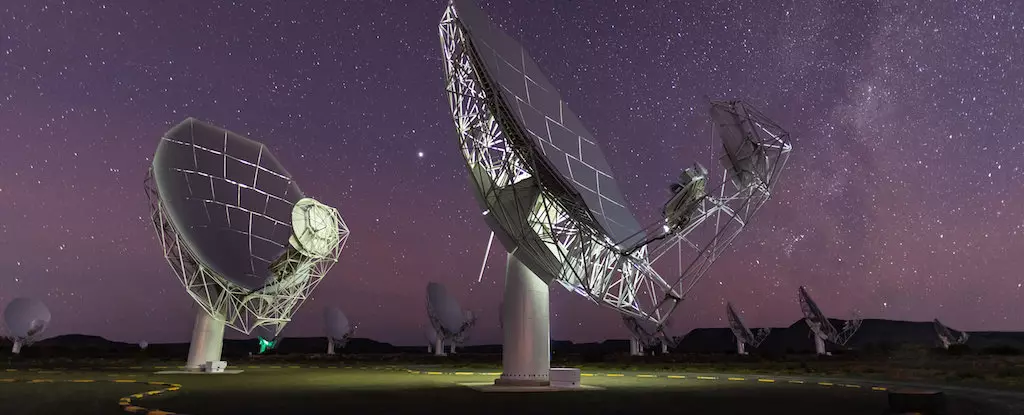Giant radio galaxies (GRGs) represent one of the universe’s most profound wonders. Spanning millions of light-years and overshadowing even our own Milky Way by a factor of thirty, these colossal structures exhibit both majesty and mystery. Recently, astronomers using South Africa’s advanced MeerKAT radio telescope have unveiled a remarkable new GRG, dubbed “Inkathazo,” which defies existing cosmic conventions. This galaxy, stretching over 3 million light-years and exhibiting peculiar characteristics, stands as a testament to the complexities of astronomical phenomena and poses intriguing questions about the underlying physics.
Inkathazo’s dimensions are astonishing, yet what truly sets it apart are its perplexing features. Unlike many of its counterparts, which share common traits, this giant radio galaxy showcases abnormal plasma jets—one of which bends rather than extending straight outward. Kathleen Charlton, the lead author of a recent comprehensive study on Inkathazo and a master’s student at the University of Cape Town, aptly reflected on its enigmatic attributes. The galaxy’s distinctive features have led to its naming, which translates to “trouble” in isiZulu and isiXhosa. “This galaxy has certainly brought about its share of challenges when attempting to decode its physics,” Charlton remarks, underscoring the hurdles faced by researchers delving into the cosmic unknown.
The existence of supermassive black holes is typically integral to the formation of radio galaxies. These black holes draw in matter and expel electrifying plasma jets that illuminate the universe at radio frequencies. However, Inkathazo adds layers of complexity to this narrative. Its unusual jet configurations provoke vital inquiries regarding their formation, especially since these jets emerge from a galaxy located within a dense cluster of other galaxies where conditions would typically inhibit such massive growth.
Usually, the environment surrounding a galaxy significantly influences its characteristics and behaviors. The discovery of Inkathazo nestled among other galaxies brings forth critical considerations about environmental impact on GRG development. Kshitij Thorat, an astronomer from the University of Pretoria in South Africa, expressed excitement over the discovery in a burgeoning cluster environment. “Finding a giant radio galaxy with such dimensions in this scenario raises crucial questions regarding how these environmental interactions play a role in the evolution of such colossal galaxies,” Thorat stated.
The striking cohabitation of Inkathazo with other galactic entities also implores astronomers to reevaluate pre-existing models of jet formation and plasma dynamics. The fact that a celestial body of this size could stand resilient against environmental hindrances may suggest new avenues of exploration or adaptions in existing cosmic theories.
To deepen their understanding of Inkathazo, the research team harnessed the capabilities of the MeerKAT telescope to create enhanced spectral age maps of the galaxy. These high-resolution maps allow for insights into the thermal age of electrons in various plasma regions. The results were surprising: they revealed that certain areas within the galaxy’s jets received anomalous energy boosts. This unexpected finding highlights the role of external influences, such as the hotter gases surrounding the galaxy, which may interact with the jets and explain the erratic energy patterns observed.
“This unprecedented discovery provides a rare opportunity to investigate the physics of giant radio galaxies with unparalleled detail,” adds Thorat. However, the results simultaneously unveil a broader truth: our current models in astrophysics might only scratch the surface of understanding the chaotic dynamics governing such expansive formations.
Once considered a rarity in the universe, the visibility of giant radio galaxies appears to be on the rise, thanks to the advent of advanced observational technologies like MeerKAT. The last five years have seen a surge in GRG discoveries, leading researchers to believe that there may be a wealth of as-yet-undiscovered galaxies lurking in the cosmos, especially within southern skies. The significance of this revelation is enhanced by the recent identification of three GRGs within a single celestial patch, illustrating the potential for exciting discoveries in underexplored regions.
Jacinta Delhaize, a co-author of the study, emphasized the immense potential that remains uncharted in Southern skies. “The identification of three GRGs within a single view demonstrates that we might just be scratching the surface of a treasure trove of cosmic mysteries waiting to be explored,” she remarked.
The discovery of Inkathazo opens a new chapter in the study of giant radio galaxies, propelling scientists into deeper inquiries about cosmic mechanics. This galaxy’s perplexing characteristics and its environment underscore the ongoing evolution of our understanding of astronomical phenomena. As discoveries continue to unfold, it becomes evident that the universe retains countless enigmas, igniting a relentless pursuit of knowledge among researchers and astronomers alike.


Leave a Reply